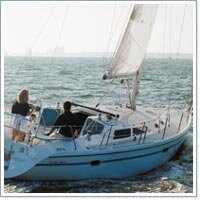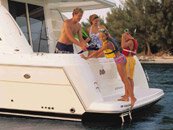Let’s say it’s an August day. Let’s gather a few meteorologists in a room with Internet access. Here’s a prediction about what will happen:
Every one of them will start looking near the Cape Verde Islands 400 miles off the coast of western Africa.
Their focus is on any low-pressure system, called “a tropical wave,” that begins over Africa and crosses warm ocean water before moving past the 10 mostly uninhabited islands. They’ll study images of each system from both geostationary and polar satellites maintained by the U.S. and other countries and watch as these “waves” continue a westward journey. On average, two of these crossing Cape Verde are the beginning of Category 3,4, or 5 hurricanes each year. Familiar hurricanes such as Andres (1992), Isabel (2003), Frances and Ivan (2004), and Dean (2007) all had their beginnings as Cape Verde tropical waves.
But as is the rule of weather, there are no absolutes.
“Katrina was a tropical depression in the central Bahamas,” notes Max Mayfield, former director of the National Hurricane Center from 1000 to 2007 and now meteorologist at WPLG-TV in Miami. “It made landfall a few days later, but it wasn’t a Cape Verde where you have days to prepare.
“Prepare” is a key word for Mayfield, who became all too familiar to us every August, September, and October during four-minute segments sitting in front of maps at the National Hurricane Center. “I like to say the battle against the hurricane is won outside the hurricane season,” he’ll tell you. There’s a simple reason for that: While Director of the Hurricane Center, Mayfield made it a point to go to landfall locations after major hurricanes and visit with people. “There’s always a lot of stress,” he observed, “and those who has a plan in place did better than those that didn’t. Boaters are going to need a longer time to prepare than those without boats because not only are they getting their boat out of the water and secured, but they also have to get their house ready.” Mayfield suggests preparing a timeline and having an idea how much has to be done and how long it will take. Once that’s complete, he says work on a “Plan B” in the event the original idea can’t be completed.
Mayfield remembers another tale of Lesson Learned. It was told by his predecessor at the National Hurricane Center, Bob Sheets. “He did a landfall survey after Hurricane Hugo in 1989 of the South Carolina coast, and spoke with the captain of a fishing boat, who stayed aboard, despite government officials saying it was time to evacuate. The skipper was an old hand and said he was not going to be scared of any ol’ hurricane. Well, the first 10 feet of the storm surge came in gradually, and the boat rose with the water; and the captain thought this wasn’t any big deal because he had the bow pointed into the wind and was doing OK. Within the next 20 minutes, another 10 feet of surge came in, and when he looked out, his boat had been lifted over a two-story house. The captain told Bob Sheets; never will he stay onboard his boat ever again.”
There are some constants as to how and when a hurricane forms. The Weather Channel’s Dr. Richard Knabb says he looks at wind speeds in the storm from the water’s surface on up to around 40,000 feet. The technical term for this is “steering flow.”
“The wind speed and direction don’t all blow the same in all levels,” he says. “It’s different at different altitudes, but if there’s more difference in speed and direction from the water’s surface to the higher altitudes, you’ll get wind shear and that’s what can tear the storm apart. However, if the steering flow between 5,000 feet and 40,000 feet is similar, meaning little difference, then that’s going to allow the hurricane to strengthen and that’s bad news. If the atmosphere around the hurricane is leading the hurricane along, then it’s not doing anything to slow it down.”
“We have to look up from the surface of the water to see if there’s going to be a potential for a hurricane taking shape,” says Mayfield, “It’s not the surface wind flow that steers a hurricane. It’s a deep-layer mean flow that steers. Think of it like a cork in the river; the river steers it down the stream. If the winds show similarity and if there is no substantial wind shear coming in that can topple the top of the thunderstorms/tropical wave, then chances are good a hurricane is going to be the result if other parameters are favorable for development, like water being sufficiently warm in advance of the storm.”
Now remember the weather saying about absolutes? Hurricane Wilma in 2005 had a 25-knot wind shear while over the Gulf of Mexico. It was considered one of the most intense hurricanes to occur (and it wasn’t a Cape Verde) as it slammed into the Yucatan Peninsula and then Florida.
Another element meteorologists such as Mayfield and Knabb look for in the Atlantic is the subtropical high that is typically centered between the Azores and Bermuda. Hurricanes usually slip below the high and steer north or continue toward the East Coast.
Richard Knabb explains it this way: “The dominant steering feature, the thing that has its hand on the steering wheel in the Atlantic, is the subtropical high. It doesn’t stay in the same place so we need to factor this with every observation. We are looking for a break in a subtropical ridge something like a strong low-pressure trough coming off the East Coast. That’s what can move the hurricane away from shore. If it doesn’t encounter a break then it will come ashore. When you have a typical mid-latitude low-pressure system, like a cold front over North Carolina, that could create a break.”
Mayfield points to Earl in 2010 as an example. A cold front roared through North Carolina just in time and with the right intensity to block Earl, a Category 4 hurricane at that point, and pushed it out to sea.
Satellite Assistants
Max Mayfield says understanding he steering currents, which he calls rivers of air, has become enhanced through the use of a Gulfstream IV (G$) that starts flying a zigzag pattern around the hurricane about three days before landfall. Launched from MacDill Air Force Base near Tampa, the jet flies to the hurricane, where it drops about 30 sensors called dropwindsondes from about 43,000 feet. Every half-second, real-time data is sent to the jet, providing air temperature, wind speed, wind direction, humidity, barometric pressure, and GPS Doppler frequency shifts that measure vertical and horizontal winds, among other characteristics, as the sensor falls to the surface. The G4 flies about 200 to 300 hours each hurricane season.
The G4 has some help now. In 2010, Global hawk, and unmanned military drone used in Afghanistan, was sent on a research experiment to Hurricane Earl, a Cape Verde storm that never made landfall but soaked the East Coast with rains. “It was launched from California, says Max Mayfield, “and flew 24 hours to monitor Earl from 60,000 feet, crossing the eye. It is able to continuously monitor a storm for many hours at a time.”
Buoy Assistance
The National Oceanic and Atmospheric Administration (NOAA) has numerous buoys in place throughout the Caribbean and the Atlantic that can provide some data as wind speeds and direction change, barometric pressure drops, and wave heights are measured. You can sit in your living room during a hurricane, pick a buoy that’s right in the middle of the action, and chances are very good it will be sending data.
“The buoy gives you the actual wind data or character data and I look at it daily,” says the Weather Channel’s Knabb. “There have been a lot of new buoys in the last few years in the West Atlantic and Caribbean and the Gulf, and they have valuable data, but they’re widely spaced. That’s a problem because you can’t get a good sense of the wind data over the surface of the ocean. That said, my favorite buoy is the one that’s closest to the storm I’m tracking, but you have to remember the buoy can’t tell you the whole story.”
We have a long way to go to educate people,” Max says when asked how hurricane forecasting fares in 2011. “It’s not about the forecast as much as it’s about building codes, land use, education and communications. We’re good at getting the forecast out but we’ve got to do a better job at communicating local emergency messages about evacuations, setting up highways to allow people to get out of the path of a hurricane, and knowing what to do before the season begins.”
Hurricane Facts
- Hurricanes rarely form within 5 degrees of the equator because the necessary spinning of air (counterclockwise in the north and clockwise in the south) can’t occur so as to move the air into a compact low-pressure center. This is called the Coriolis force. Winds in the Northern Hemisphere are pulled to the right by the Earth’s rotation.
- Hurricanes lose intensity over cold water and land.
- Most Names: There were 28 named storms in 2005. The National Hurricane Center went through the approved names (only 21 of the 26 letter are used; Q,U,X,Y and Z are not) and then a secondary list using the Greek Alphabet (Alpha, Beta, Gamma, and so on). In the Eastern Pacific, the letters X,Y, and Z are included in choosing hurricane names.
- Lowest Barometric Pressure: During Hurricane Wilma, air pressure was measured at 26.10 inches.
Does He Know Something
Max Mayfield walked into a Costco a few years ago to buy a case of bottled water for his daughter’s softball game. Shoppers recognize him from his television live shots at the National Hurricane Center and started asking all about why. “They thought the world was going to end, “ he noted. This wasn’t the first time, though. Some years earlier, he went to Home Depot to buy batteries and was recognized from his likewise work on TV. People came up to him asking if he knew something they didn’t. Max asks his wife to buy batteries and water now.
NOAA Changes to Watches And Warnings
A year ago, the national Weather Service changed when hurricane watches and hurricane warnings are posted to allow for more time to prepare and evacuate.
A Hurricane WATCH is issued for coastal areas when hurricane conditions could threaten to hit within 48 hours (it used to be 36 hours). A Hurricane WARNING is a heightened alert that is issued when hurricane conditions threaten to hit within 36 hours or less (it used to be 24 hours).
For More Information
BoatU.S. Hurricane Resource Center
National Hurricane Center
National Data Buoy Center

